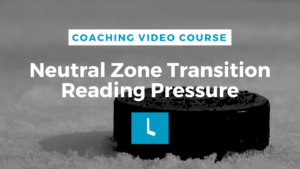Grey Zones in hockey are part of the zone five feet on either side of the blue line or about a meter and a half on either side. What is important about these areas of the ice?
Whether it’s your defensive zone blue line or it’s the offensive blue line, turnovers generally result in odd man situations like a 2 on 1, 3 on 1 or a breakaway. The reason is because most players are moving in one direction and a turnover creates these gaps.
*Audio transcribed from How to Play Hockey: Our Minor Hockey Coaching Course.
Offensive Grey Zones:
We’re entering the offensive zone against the opposing D1 and we try to make a move right past the blue. Our F2 and F3 are going hard, our D are also trying to follow up. If we turn the puck over in that area and we’re moving up ice like this, all it takes is a turn over and then a quick chip and the other team that has been back checking quickly regroups and goes on and on an odd man rush.
Generally we say get the blue line, get through the grey zone and then try to make your play. There are a few players in the game that have been great at coming over the blue line and stopping just inside with the puck and being able to create offense. I like to tell players that it really puts you in a tiny little phone booth with no room to play and for the mathematicians out there you only have about ninety degrees of options to work with. So if you can get through that grey zone on and get down and delay down near the half wall if that’s the play you’re trying to make. Now the mathematician can see about one hundred eighty degrees of vision and plays can be made back up to the blue line or into the corner or into the middle. So getting it out of this grey zone will give you many more options.
Defensive Grey Zones:
Let’s say we’re on defense and our W is carrying the puck out of the zone just above the circles and instead of chipping it pass the opposing D1, he/she tries to beat him one on one and all of our players are coming up out of the zone again this turnover is going to turn into a good scoring chance going back towards our own net or certainly an odd man situation. It’s times on the ice when you’re a team, assuming something good is going to happen and they start to adjust to an offensive position where they don’t have time to transition to a defensive position that we get in trouble.
Grey Zones and Gaining/Holding the Line
So grey zones and holding the line are very connected concepts, the better you can hold the line the better you can create an offensive turnover for yourself in the grey zone. And make sure not to be to fancy once you cross that opposing blue line, keep it smart and simple.
Be sure to watch the video for an even more detailed description of ‘Grey Zones.’
More Minor Hockey Coaching Resources
Looking to download half ice hockey practice plans, goalie drills for teams (not a goalie coach?!) or small area games drills? We’ve got you covered too. Click here. Perfect for recreational level coaches.






